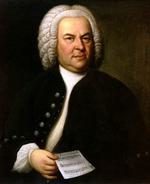
News Story
First things first – what are the Brandenburg Concertos all about?
The Brandenburg Concertos, originally titled ‘Six concertos for several instruments’, were composed by Johann Sebastian Bach over several years from 1711–1720. Today, they’re widely seen as some of Bach’s best work and serve as a perfect introduction to the world of Baroque music. Each concerto was written for a different combination of instruments and demonstrates a musical style that was popular in Bach’s lifetime. It’s thought that this variation was intended to show off the instrumental strength of the Cöthen Court Orchestra, giving each musician a chance to demonstrate their virtuosity.
Why did he write them?

Portrait of Johann Sebastian Bach
The concertos as we know them today can be seen as a particularly labour-intensive job application. In 1721, Bach sent the compositions to the Margrave Christian Ludwig of Brandenburg, the younger brother of King Frederick I of Prussia. Bach accompanied the music with a self-deprecating note thanking him for his interest in ‘the small talent that Heaven has granted me for music’. Not so coincidentally, Bach was coming to the end of his role as the director of music at the princely court of Cöthen and looking to secure further employment. Bach had met the Margrave Christian Ludwig of Brandenburg a couple of years before and promised to provide him with some compositions.
It’s believed that rather than writing new pieces specifically for the Margrave, he picked out a compilation of previously performed works that he felt exemplified his abilities and adapted them for this presentation. Unfortunately, it appears that the Margrave never replied to Bach, nor had the compositions performed, so we’ll never know if he’d have approved of his name being attached to the work. Thankfully it’s unlikely that Bach was too disheartened by this, as he found a job shortly afterwards as the musical director at one of the oldest schools in the world: Thomasschule in Leipzig, a role he then held for 27 years.
Why are there six of them?
A pre-occupation with numbers runs throughout Bach’s work. Ever humble, he had a particular fondness for the numbers 14 and 41 as they were equal to the mystical numerology values of the letters in ‘Bach’ and ‘JS Bach’ respectively. Although the significance of the number six is less apparent, it also appears frequently throughout his work. As well as his compositions ‘Six Suites for Solo Cello’ and ‘Six Partitas for keyboard’, he is believed to be the author of a poem on the theme of smoking a pipe, which consists of six stanzas. There’s a reason Bach is better known for music than poetry, but truly devoted fans can enjoy some Edifying Thoughts of a Tobacco Smoker here.
Who’s performing them?
This performance, recorded as part of our At Home series in partnership with abrdn, is led by conductor and harpsichordist Richard Egarr, a specialist in baroque music. He hand-picked an ensemble of period musicians from across the world especially for this International Festival appearance. The concert marked the finale of the 2022 Queen’s Hall series and received glowing reviews, with critics particularly praising Egarr for his ‘Elton John-like’ harpsichord playing. You can watch a characteristically dynamic solo performance at the Utrecht Early Music Festival here.
Tell me about Richard Egarr
Now an internationally known conductor, Richard Egarr has been a classical music enthusiast since childhood and trained as a choirboy at York Minister and Chetham’s School of Music. Although he specialises in Baroque music, he has played and performed music from a wide range of historical periods and enjoys subverting expectations around how a performance of early music should look and sound. Having worked on both historically informed performances and modern interpretations, Egarr says that for him ‘the real joy comes in taking that experience and translating it into a language that’s digestible for a modern orchestra’. He acknowledges that ‘much of this music relies on modern players for its survival’ and has worked to introduce audiences around the world to this repertoire in an approachable and entertaining way.
How can I watch it?
The concert is available to watch via our YouTube channel. The recording is part of our 2022 At Home programme in partnership with abrdn.
Get in on the act – become a Friend today
- Access to priority booking
- Exclusive members events
- Discounts and offers
- More benefits


